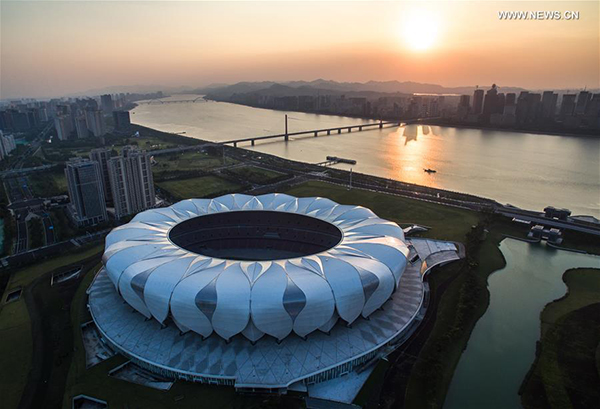Belt and Road Initiative for global benefit
By Wang Yiwei (China Daily) Updated: 2016-08-31 07:54
 |
|
Photo taken on Aug 25, 2016 shows the Hangzhou Olympic Sports Center in the Binjiang district of Hangzhou, capital of East China's Zhejiang province. Hangzhou is the host city for the upcoming G20 Summit.[Photo/Xinhua] |
The international community hopes the G20 summit in Hangzhou, East China's Zhejiang province, will raise global investments and optimize the use of financial mechanisms. And given its framework, the G20 should view the China-proposed Belt and Road Initiative and Asian Infrastructure Investment Bank as a boon for stabilizing the faltering world economy.
The Belt and Road Initiative, the Silk Road Economic Belt and 21st Century Maritime Silk Road, is essentially aimed at providing efficient supply for stimulating fresh demand, with a focus on infrastructure investment in both developed and developing economies. That many countries, ranging from the United Kingdom to the ASEAN members, have shown interest in endorsing the Belt and Road Initiative highlights their desire to use innovative means to improve their domestic infrastructure.
But the loose economic coalition needs financial institutions such as the AIIB and the BRICS New Development Bank to coordinate the participation of governments, enterprises and other institutes, as well as to diversify financing channels. Apart from the two international banks led by China, the country's State-owned and commercial banks, too, have a role to play in implementing the Belt and Road Initiative, which features public-private partnership, or PPP.
Take for example the AIIB, the first multinational financial institution established on Beijing's proposal. It has the potential to deepen global political and economic cooperation and provide funds for the infrastructure projects for the Belt and Road Initiative.
Sharing the pursuit of boosting infrastructure investment, both the Initiative and the AIIB pledge to make global governance "lean, clean and green", endorse open regionalism, and are committed to realizing the United Nations Sustainable Development Goals by 2030.
But it is not true that they are affiliated to or subject to one another, a popular misreading among some China observers who cannot accept China's rise and believe its participation in global governance comes with grave security risks. Some have even played up Beijing's so-called challenge to the Washington-led world order, calling the Belt and Road Initiative and the AIIB a threat to the environment and the rule of law.
The fact is, China still needs the support of the United States, the world's largest economy, to carry forward its strategic plans, although some US politicians remain suspicious of the intentions and feasibility of the Belt and Road Initiative. Therefore, more measures have to be taken to convince them that stabilizing global growth is in China's own interest.
But Washington, on its part, also has to learn a lesson or two from its failed attempts to dissuade some of its close allies, like the UK, from joining the AIIB. In other words, both China and the US should work closely to improve global infrastructure and economic integration, in a bid to upgrade their bilateral ties.
The US is a world leader in building soft infrastructure, ranging from capacity building and skills development to legal systems, while Beijing has an equally impressive record in infrastructure construction, including transport and telecommunications, especially in recent years.
The two sides, therefore, should learn from each other to bridge the widening gap between the demand for international public goods and the insufficient supply, which is exactly what the Belt and Road Initiative seeks to achieve.
In Asia alone, at least $8 trillion are needed for infrastructure projects over the next 5 to 10 years to improve connectivity. So the newly established AIIB with a capital of $100 billion and the $40 billion Silk Road Fund should be welcomed rather than opposed by relevant countries.
The author is a professor of international relations at Renmin University of China.
- Egypt eyes bigger role in Belt and Road initiative at G20 summit: MENA chief
- Belt and Road Media Community launched in Beijing
- Nepal's private sector forms body to promote Belt and Road Initiative
- China making headway on Belt and Road Initiative
- China's Belt and Road Initiative conducive to reviving world economy: Senior UN official
- Belt and Road ambassadors attend forum in Yantai
- Official calls on media to support Belt and Road
- China's Belt and Road Initiative conducive to efforts to carry out UN sustainable development agenda












